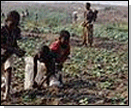
Amidst optimism about the growth prospects of the agricultural sector and consequently the fertiliser industry, policy environment continues to remain fluid. Given this backdrop combined with the imminent rise in gas price, will manufacturers be able to maintain margins?
|
|
The Pricing Policy with regard to Di-Ammonium Phosphate (DAP) fertilisers needs to be modified appropriately and periodically taking into consideration the actual present cost of raw materials and freight rates. An anti dumping/ safeguard duty also needs to be imposed on imported DAP so as to prevent dumping of stocks in India. |
|
|
|
Also, as a step towards reducing subsidy on fertilisers, cost of inputs and manufacture need to be reduced. This can be achieved by granting duty exemptions on plant, machinery and equipment for all new and expansion facilities proposed to be set up, including LNG units since these supply LNG to critical industries of power and fertilisers. |
| Budget 2002-03 |
|
Budget 2003-04 |
|
Budget 2004-05 |
|
|
|
|
|
|
Decannalisation of the export of agriculture commodities and phasing out of remaining export controls.
A new corporation for Agricultural Insurance to be promoted by the existing public sector general insurance companies.
Steps to reduce large food grain stock and launching of the food for work programme.
Modest increase in the issue price of urea, DAP, MOP by about 5%. Subsidy for SSP reduced by Rs 50 per tonne. |
|
To pass the benefits of lower interest regime, the SBI has announced an interest rate band of 2% above and below the PLR for secured advances.
Issue prices of fertilisers to be raised by Rs 12 per bag for urea, Rs 10 for DAP and MOP per bag. The prices of complex fertilisers to be suitably modified. |
|
Excise duty on LNG exempted.
Doubling agricultural credit in three years, accelerating the completion of irrigation projects and investing in rural infrastructure. |
| |
|
|
|
| |
| Key Positives |
|
|
|
Low per-capita consumption: India consumes only 98 kgs of nutrients per hectare of arable land as compared to 254 kgs in China, 301 kgs in Japan and 407 kgs in Korea. Several developing nations including Pakistan and Bangladesh have higher consumption per hectare at 135 kgs and 156 kgs respectively. |
|
|
Increased credit availability: Though credit availability to the agriculture sector has been an issue, various measures have been taken to increase the availability of credit at a cheap rate. The emergence of the commodity exchange and plans on the crop insurance side are a step in the right direction to provide a fillip to the agriculture sector. Since fertiliser demand is a function of awareness of usage and availability of organised credit, this is expected to benefit the industry. |
|
|
Critical to food security: The impetus to provide a boost to the fertiliser sector stems from the fact that the country needs to have food security. Given the rise in population and falling area under cultivation, this is likely to be achieved by improving productivity. Therefore, policy measures are likely to be accelerated on the fertiliser side. | |
|
| Key Negatives |
|
|
|
Political intervention: Since the farmer section is a large vote bank, both at the center and at the state level, there has been a hesitancy to take hard decisions. This has been affecting the growth of the fertiliser sector. |
|
|
Unclear policy environment: The sector is a highly controlled one (cap of capacity, prices, selling markets and return generation). The lack of incentive to cost-efficient producers as compared to incompetent players has been affecting not only the industry fortunes but also the government's finances. Till 2006, policy environment is likely to remain fluid. |
|
|
Gas de-regulation Natural gas is one of the cost-efficient sources of energy for the fertiliser industry. But gas prices are controlled in India, fertiliser manufacturers in India have been benefiting. Considering the imminent deregulation in the gas sector, there could be a sharp rise in input cost. The availability of gas at competitive rates is also an issue that needs to be addressed with high priority. | |
Budget 2005-06: Complete Coverage

Equitymaster.com is one of India's premier finance portals. The web site offers a user-friendly portfolio tracker, a weekly buy/sell recommendation service and research reports on India's top companies.









 © 2025
© 2025